| Pages:
1
2
3 |
bulerias1981
Oud Junkie
    
Posts: 763
Registered: 4-26-2009
Location: Beacon, NY
Member Is Offline
Mood: John Vergara Luthier Lord of the Strings instrument making and repair
|
|
I guess ebony is more practical, lasts long.
Curls and strips are hard to work with as you said. I find it best to use a plane with a toothed blade. You can also use a Lie-Nielsen scraper plane
which you have the option of using a toothed blade.. Then when you're close to the thickness you need, you fall back to a regular scraper and scrape
out the tooth marks.
Another question:
Ever see maple for a bridge on an oud?
|
|
|
Peyman
Oud Junkie
    
Posts: 496
Registered: 7-22-2005
Member Is Offline
Mood: Mahoor
|
|
I might have seen dyed maple bridges but I am not competely sure. Maybe someone esle has a better answer. I might be thinking lutes. Either way, I
think it would look really nice. It's your project and you can sure make a unique oud.
|
|
|
bulerias1981
Oud Junkie
    
Posts: 763
Registered: 4-26-2009
Location: Beacon, NY
Member Is Offline
Mood: John Vergara Luthier Lord of the Strings instrument making and repair
|
|
An interesting thing I read in "Historical Lute Contstruction" by Robert Lundberg printed by the Guild of American Luthiers...
If you have the book, you can see on page 68 where he discusses the use of ebony as a use in historical lutes. And I'll quote,
"The first thing one notices is that historical pegs are not made of ebony! It is wisely known today that ebony is a terible wood for pegs. The wood
contains so much silicon that the peg holes are soon worn out and a new set of pegs must be fitted. After a couple of sets of pegs, the holes in the
pegbox must be bushed. Historical makers instead chose woods like boxwood, plum, mountain ash, and other locally available hardwoods which were very
stable and were known to wear well. I have had samples identified as pear, laurel and lilac."
This is very interesting and don't know why I haven't thought of it. I knew mineral deposits existed in ebony, which can eat up plane blades or other
cutting tools. Didn't think about its effect on the pegbox walls. Obviously the wear takes time and a lot of tuning for it to have that effect. But if
you have had an instrument with ebony pegs, with time, you do see that the begin to protrude out more and more from the end of the pegbox!!
Still doesn't answer my question about maple being good for pegs. I also searched in this book for the use of maple on fingerboards on lutes, and is
not mentioned. Along with maple for the bridge.
|
|
|
Sazi
Oud Junkie
    
Posts: 786
Registered: 9-17-2007
Location: Behind my oud
Member Is Offline
Mood: مبتهج ; ))
|
|
Quote: Originally posted by bulerias1981  |
I want to start a question for everyone...
Have you seen curly maple as a fingerboard? I'm considering using that. I've seen them on baroque violins, viols. But what about ouds/lutes? Any
opinions? I'm trying to keep the oud themed with walnut and maple only. No ebony or roserood. Not even for the bridge, fingerboard, inlays or pegs.
Even the pegs I'm planning to make myself on my lathe from maple. |
Had one oud with dyed maple bridge (that I know about).
I have had a great oud with Walnut for the fingerboard, bridge and pegs, (everything except the soundboard actually), and you can find some really
lively grain patterns in walnut too, for visual interest.
|
|
|
jdowning
Oud Junkie
    
Posts: 3485
Registered: 8-2-2006
Location: Ontario, Canada
Member Is Offline
Mood: No Mood
|
|
Ebony is said not to be the best wood for pegs because it contains abrasive salts that act like sandpaper causing excessive wear. It is also not
recommended for bridges (too heavy?) - although I have, in the past, successfully used ebony for both pegs and bridges (on lutes) so reckon that
claims of excessive peg wear are a bit exaggerated.
Boxwood is OK but it takes forever to season to a stable state necessary for use as pegs without problem. I have lots of the stuff 30- 100 years old
and have often used it for pegs.
I also have some well seasoned lilac in stock that is a hard, dense wood, pale violet in colour but have never tried it as a peg material.
Old lutes generally used pear wood for both pegs and bridges - stained black - said to be the best choice.
I have used Maple (Sycamore) for lute bridges but not for pegs (too soft). Walnut is probably also too soft for pegs.
Brazilian rosewood is good for pegs - it contains oils that make it easy to turn on a lathe and which act as a natural peg lubricant. Probably not
legally available these days as it is an endangered species.
Ebony is and was used for fingerboards because it is hard and black - so wears well and doesn't show stains from finger oils as lighter coloured woods
like maple or boxwood surely do.
More exotic fingerboard materials found on surviving lutes are ivory and tortoise shell. The latter, with a gold leaf underlay, makes an impressive
looking fingerboard. Ivory was also used for lute pegs.
|
|
|
Peyman
Oud Junkie
    
Posts: 496
Registered: 7-22-2005
Member Is Offline
Mood: Mahoor
|
|
I have Lundberg's book too. It's an interesting book.
I remember Jameel's first project had a walnut bridge too. As for pegs, I used to have maple pegs on a saz of mine and they worked for 12 years untill
they started to protrude. I guess longevity of pegs/the peghead holes is somewhat relative. I personally like rosewood. Dr. Oud has written about the
choice of peg wood in this forum a few times.
|
|
|
vinzenz
Oud Admirer

Posts: 5
Registered: 12-22-2010
Member Is Offline
|
|
The best woods for pegs are in my opinion cocobolo, rosewood, plumwood, boxwood. the wood should not be too hard, rather more resilient. And when you
use basswood for the inside of the pegbox with only a thin (1 - 2 mm) veneer of your decorativ wood, it works really fantastic. just a little clay or
soap - thats it.
when you turn the pegs there are no squeak , no rattle etc. and the peg is not suddenly out of the hole - sorry , i hope you understand what i want to
say, maybe my english is not the best for this technical terms,
and the tapering should not be too much.
For the bridge i use stained beechwood ( quartersawn ) as i found on a really old turkish oud. You can really tune your oud by changing the wood for
the bridge. i think: Brazilian rosewood for the most brilliant sound , then mayby indian rosewood for a little bit less and so on- you have to get
your own experience.
Vinzenz Bachmayer
Luthier
Unterer Anger 16
80331 München
Germany
|
|
|
jdowning
Oud Junkie
    
Posts: 3485
Registered: 8-2-2006
Location: Ontario, Canada
Member Is Offline
Mood: No Mood
|
|
Just to add to the observations made by vinzenz.
The peg box of my old Egyptian oud is made from a beech wood/rosewood (?) laminate with pegs of an unidentified softer wood stained black. So the pegs
- in this case - will wear faster than the pegbox. For hard pegs in a soft peg box, the peg box will wear faster. Either way pegs and peg box
materials should be of a different hardness. Like vinzenz, I prefer hard pegs in a softer peg box for a smooth peg fit. Also pegs made from harder
woods are usually easier to turn in a lathe with good detail.
When working with oily woods like Brazilian rosewood gluing can be a problem unless the surface of the wood is thoroughly de-greased prior to gluing.
|
|
|
Sazi
Oud Junkie
    
Posts: 786
Registered: 9-17-2007
Location: Behind my oud
Member Is Offline
Mood: مبتهج ; ))
|
|
That's for sure! I'm glad I play floating bridge oud's, makes it nice and easy to change and compare, (well, once you've made a few bridges)... and it
can make a huge difference.
|
|
|
Sam
Oud Junkie
    
Posts: 375
Registered: 3-23-2009
Location: Cairo - Egypt
Member Is Offline
Mood: Selling Ouds
|
|
bulerias1981 ,
Maple wood for bridge ?? I don't think it's a good idea. brigde wood should be a wood that has specific properties .
1- should be very light and strong in same time.
2- should be able to transfer the sound from strings to soundboard as fast as possible.
as I've heard , Brazilian rosewood was the most pupolar bridge wood ever . due to the illegal logging , The Brazilian goverment has banned trading
with Brazilian rosewood in fear BRW wood will be no more exist.
You can either use Walnut or Paduk wood for bridges .especialy Paduk , Very light and easy to work with. It makes a perfect bridge for an Oud.
Sam
|
|
|
bulerias1981
Oud Junkie
    
Posts: 763
Registered: 4-26-2009
Location: Beacon, NY
Member Is Offline
Mood: John Vergara Luthier Lord of the Strings instrument making and repair
|
|
Ok. so my rib thickness is at 1.5 Which is pretty thin for an oud I believe. Any thoughts on this?
I have been busy, so I haven't posted photos. I'll post some later today. Thanks.
|
|
|
Jonathan
Oud Junkie
    
Posts: 1582
Registered: 7-27-2004
Location: Los Angeles
Member Is Offline
Mood: No Mood
|
|
Don't use maple. Too heavy--you want the soundboard to be able to vibrate as much as possible.
If you want the traditional dark black bridge, dyed pear wood would work nicely.
Rib thickness is 1.5 mm after you have sanded it all down? No need to worry, as long as the joints seem secure. As you know, if the thickness of the
rib is 1.5mm, it tends to be much narrower at the joint, because of the sanding.
I tend to go just a bit thicker, but a lot of the masters made ouds with ribs that were about that thick. (Although I am not sure how much further
shrinking of the thickness of the ribs takes place through the years).
|
|
|
bulerias1981
Oud Junkie
    
Posts: 763
Registered: 4-26-2009
Location: Beacon, NY
Member Is Offline
Mood: John Vergara Luthier Lord of the Strings instrument making and repair
|
|
Ok.. I know.. Shame on me for not posting each step of the way.. But it became time consuming and I wanted to concentrate on making the oud itself
without too many distractions. So here it is, finally. I started this back in November I believe, so its been a long journey and I learned a lot.
I wouldn't say it came out perfect, but I'm happy with the final results. About the sound, I'm very impressed. It has plenty of projection, with a
somewhat traditional sound. I cant wait to see what happens with time as it matures.
I used a minwax laquer to finish it, and I wasn't totally happy with the results as it ended up a bit bumpy. I'll likely apply another coat or two in
the near future and take down the high spots.
I decided to make the pegs myself using my lathe and a duplicator. Modeled after traditional Nahat style pegs. They came out pretty good. I went
against many by using maple, however, I took time to fit each peg, and there is no problem that I can see, and they work rather fine. If theres a
problem, I'll try boxwood, but its ok for now in my opinion.
I used a figured maple as the fingerboard with a light coat of refined linseed oil to protect it. (well see how that goes, though I'm generally good
about wiping the fingerboard each and everytime I play.
The bridge came off after a few hours being tuned. So I used a stronger glue (Titebond III). I used hyde glue before. I'm still not sure if it was the
glue consistancy or the way I clamped it which caused the fail or both. But I made a special jig that places pressure down on all surfaces of the
bridge. So I believe that and the stronger glue choice, it should stay.
Sound file and/or video to come! Feel free to ask any questions or request any additional photos as there are many.


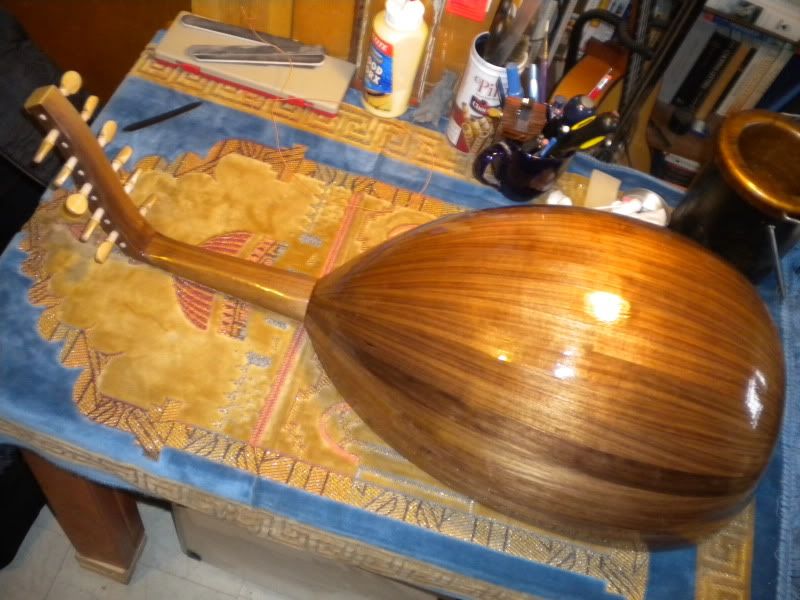
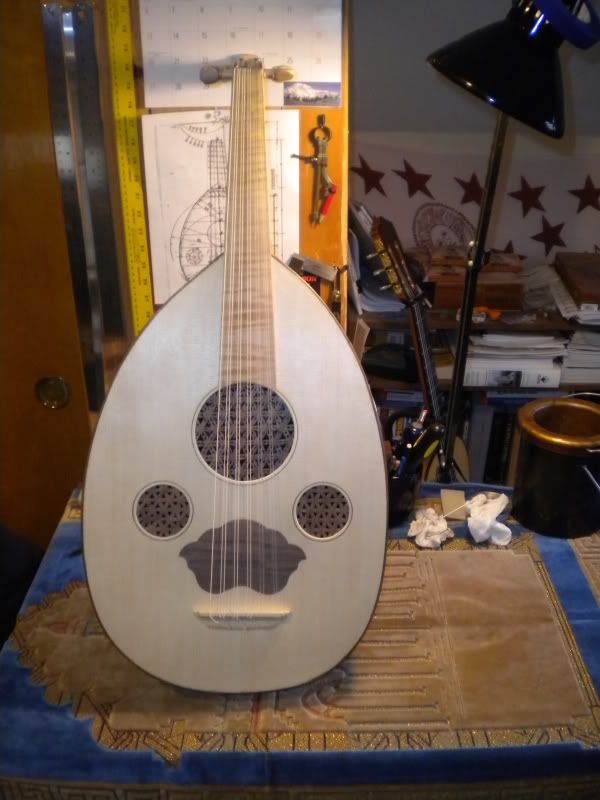
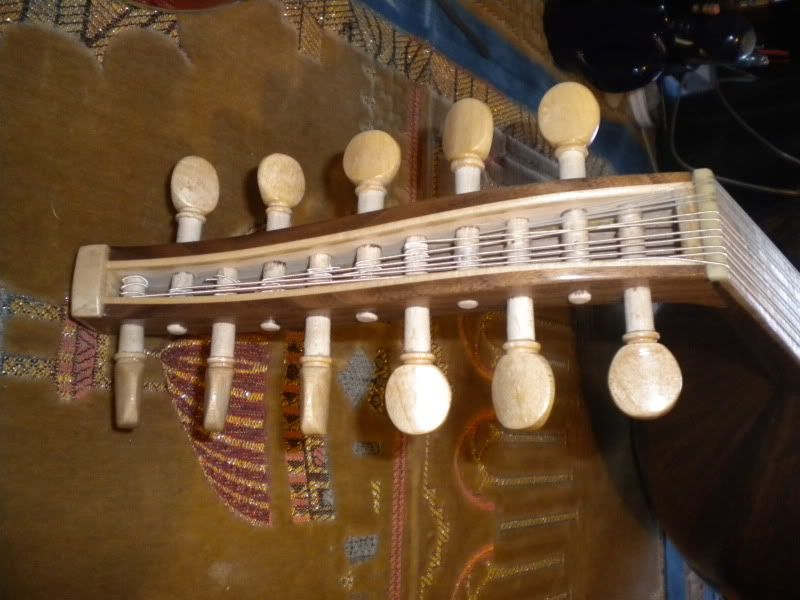
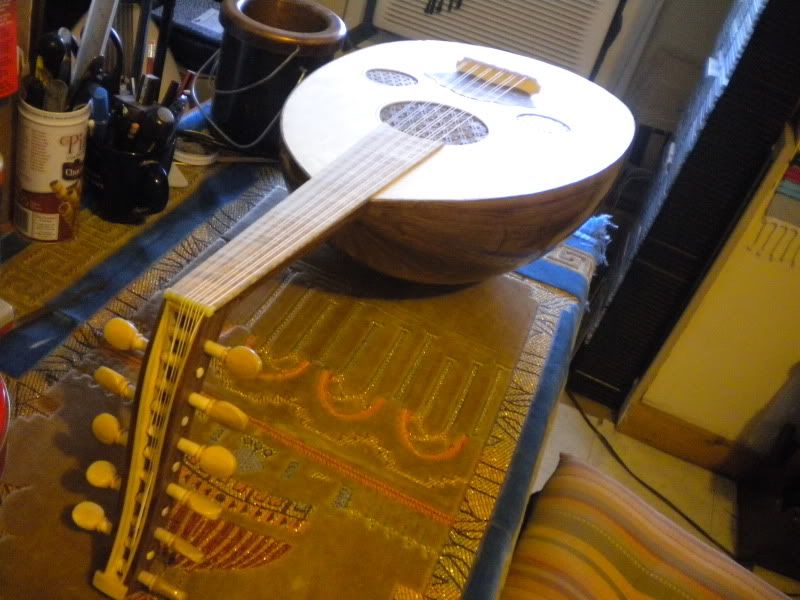
|
|
|
SamirCanada
Moderator
     
Posts: 3404
Registered: 6-4-2004
Member Is Offline
|
|
NICE! very very nice.
that feeling when you finally put the strings on the finished instrument is soo nice. Your first oud is really a beauty and you should be really proud
of your work!
Mabrouk and lets hope you play it in health.
love the curly maple fingerboard. first time I see that on a oud. its a nice touch.
welcome to the crazy hobby oud maker club :P
@samiroud Instagram
samiroudmaker@gmail.com
|
|
|
bulerias1981
Oud Junkie
    
Posts: 763
Registered: 4-26-2009
Location: Beacon, NY
Member Is Offline
Mood: John Vergara Luthier Lord of the Strings instrument making and repair
|
|
Thanks so much Samir. I'm new to the oud making club I guess! Thanks for the welcome!
Here are two pieces I recorded on the fly as everyone says... It could be better, it was just a quick recording! 
Taqsim Bayati en La http://www.4shared.com/audio/LI69DlCV/John_Vergara_new_oud_taqsim_b...
First khana for Tutta by Farid Al Atrash
http://www.4shared.com/audio/JGSB9Nt3/John_Vergara_new_oud_Tutta.ht...
|
|
|
paulO
Oud Junkie
    
Posts: 531
Registered: 9-8-2004
Location: California
Member Is Offline
Mood: Utz
|
|
Hi Bulerias,
What a unique look, and excellent craftsmanship -- the sound really surprised me; really sweet sounding mids/trebles with some really fine sounding
bass -- congratulations; play it in good health - and thanks for sharing the project.
Cheers..Paul
|
|
|
Brian Prunka
Oud Junkie
    
Posts: 2916
Registered: 1-30-2004
Location: Brooklyn, NY
Member Is Offline
Mood: Stringish
|
|
Great job, the oud sounds really good. It can only get better with age and lots of playing!
|
|
|
bulerias1981
Oud Junkie
    
Posts: 763
Registered: 4-26-2009
Location: Beacon, NY
Member Is Offline
Mood: John Vergara Luthier Lord of the Strings instrument making and repair
|
|
Thank you paulO and Brian!! I am happy with this first oud, but I'm setting oud to make my second one!!
|
|
|
Yaron Naor
Oud Junkie
    
Posts: 275
Registered: 1-24-2009
Location: Bat Hefer, Israel
Member Is Offline
Mood: Happy
|
|
Nice work!
Nice work! 
I am interested to see a closer look on the rosette...
and what are your things that you are going to do different for the second one?
Thanks for shearing
Yaron.
|
|
|
bulerias1981
Oud Junkie
    
Posts: 763
Registered: 4-26-2009
Location: Beacon, NY
Member Is Offline
Mood: John Vergara Luthier Lord of the Strings instrument making and repair
|
|
Quote: Originally posted by Yaron Naor  | Nice work! 
I am interested to see a closer look on the rosette...
and what are your things that you are going to do different for the second one?
Thanks for shearing
Yaron. |
Thanks Yaron. I enjoy your work too. Here is a closeup of the rosettes.
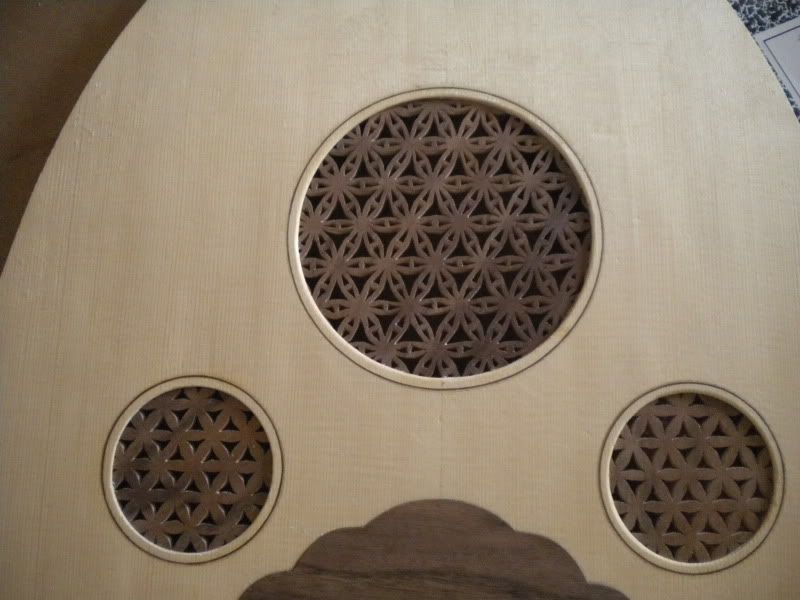
|
|
|
Yaron Naor
Oud Junkie
    
Posts: 275
Registered: 1-24-2009
Location: Bat Hefer, Israel
Member Is Offline
Mood: Happy
|
|
Wow, very nice work, can you show how did you make it?
Especially the big one. (is it cherry wood?)
Thanks.
|
|
|
bulerias1981
Oud Junkie
    
Posts: 763
Registered: 4-26-2009
Location: Beacon, NY
Member Is Offline
Mood: John Vergara Luthier Lord of the Strings instrument making and repair
|
|
Sure. It began with a piece of maple, with a walnut veneer glued to it. The rosette pattern based the "Brussels M.I.M. oud #0164" as posted by
Jdowning in his thread "Old Oud compared to Old Lute Geometry"
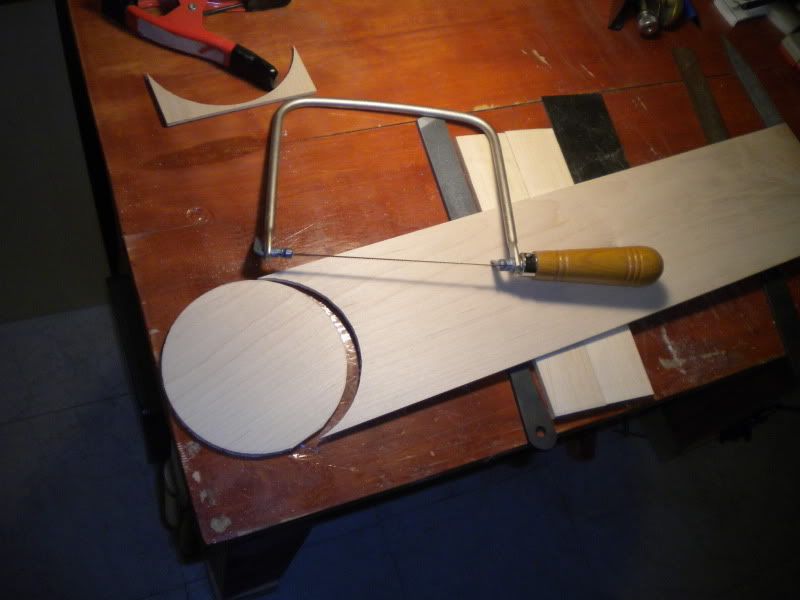 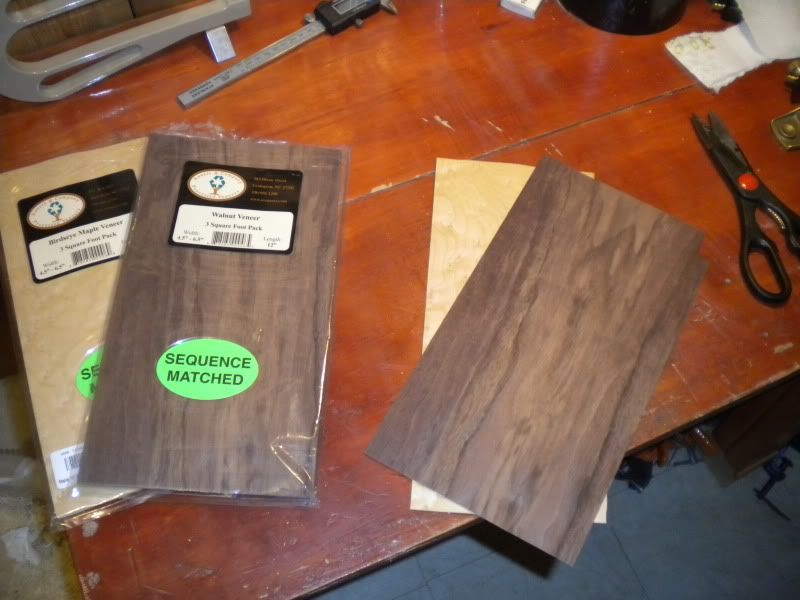 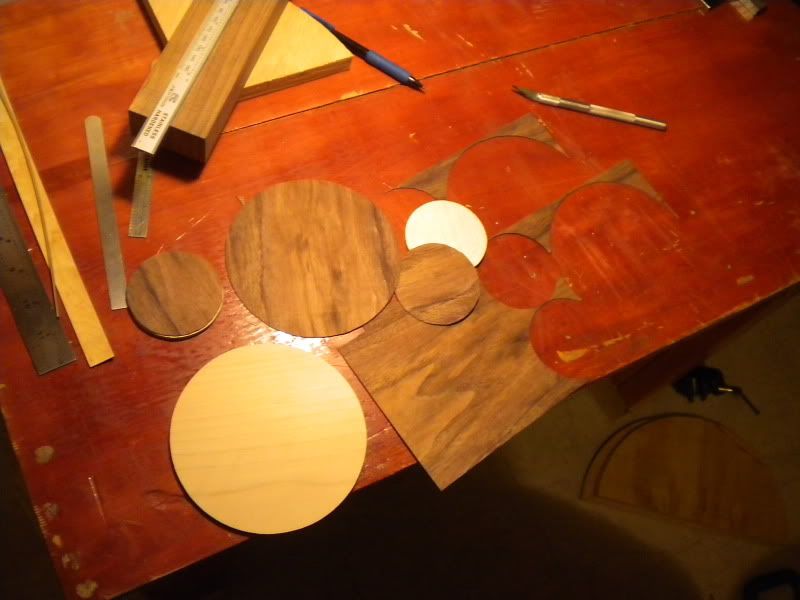 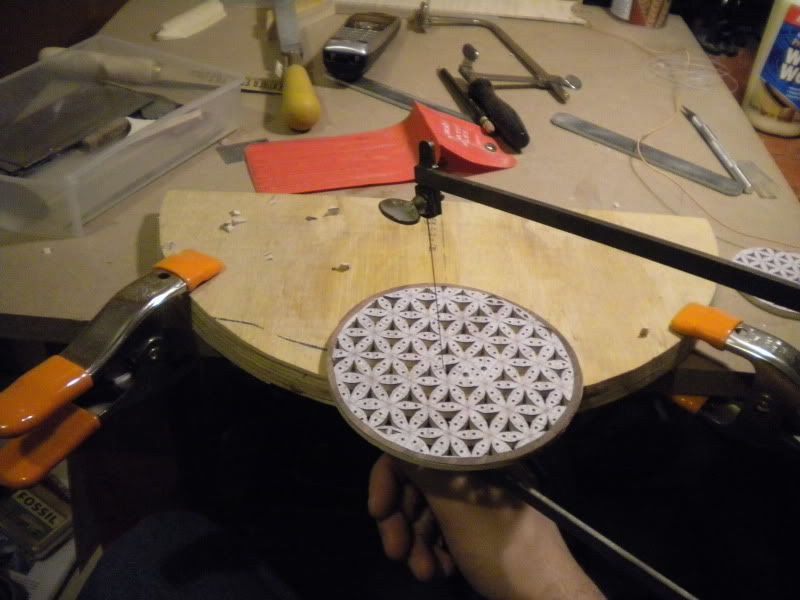
|
|
|
Yaron Naor
Oud Junkie
    
Posts: 275
Registered: 1-24-2009
Location: Bat Hefer, Israel
Member Is Offline
Mood: Happy
|
|
Cool! very good work
Thanks for the images. (lots of blade removing/installing)
Yaron
|
|
|
bulerias1981
Oud Junkie
    
Posts: 763
Registered: 4-26-2009
Location: Beacon, NY
Member Is Offline
Mood: John Vergara Luthier Lord of the Strings instrument making and repair
|
|
Hello all.
As a follow up, just after the completion of my previous oud, my cat (while playing with a piece of paper) knocked this oud down while I had it
leaning against the dressed, and the top was damaged. I could have chosen to repair it. But I decided to remove the top all together and then rebuild
a new top.
The new top is different, having one soundhole. A different rosette that I cut by hand (beautiful design by Alfaraby with my name in Arabic at
center), different decor around the soundhole (thicker purfling with pearl inlays), and a different bridge.
I also changed the bracing scheme, used thicker braces and placed them in slightly different places. And I'm very happy with the end result. I love
the sound. Its punchy, has projection.
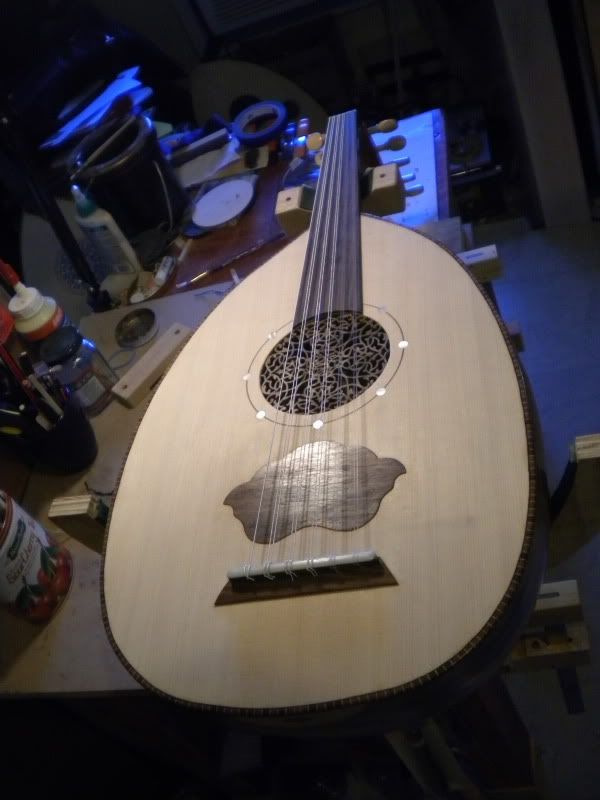
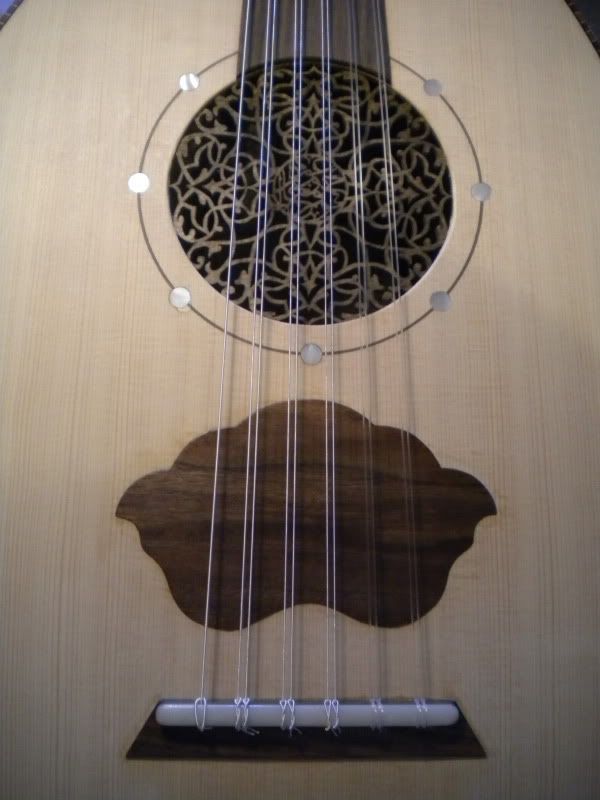

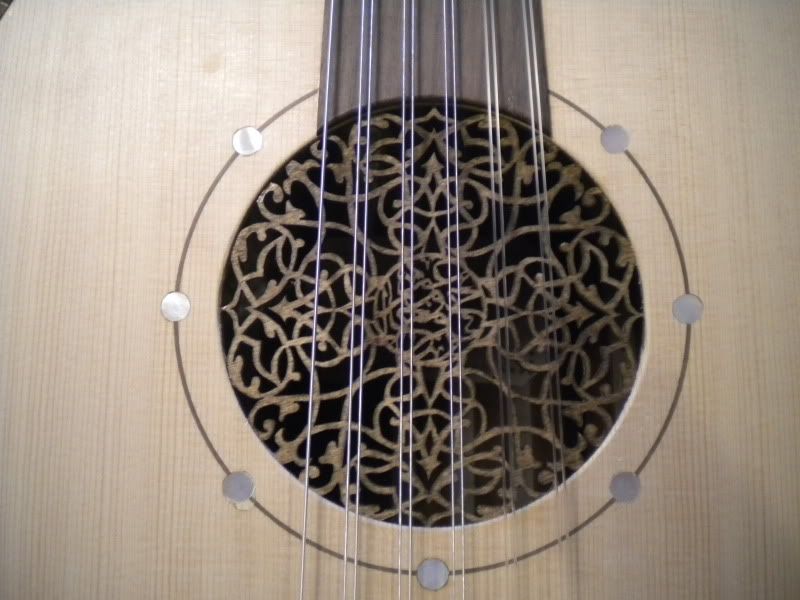
|
|
|
SamirCanada
Moderator
     
Posts: 3404
Registered: 6-4-2004
Member Is Offline
|
|
Nayce!!!
Love the new top. Looks sharp
@samiroud Instagram
samiroudmaker@gmail.com
|
|
|
| Pages:
1
2
3 |